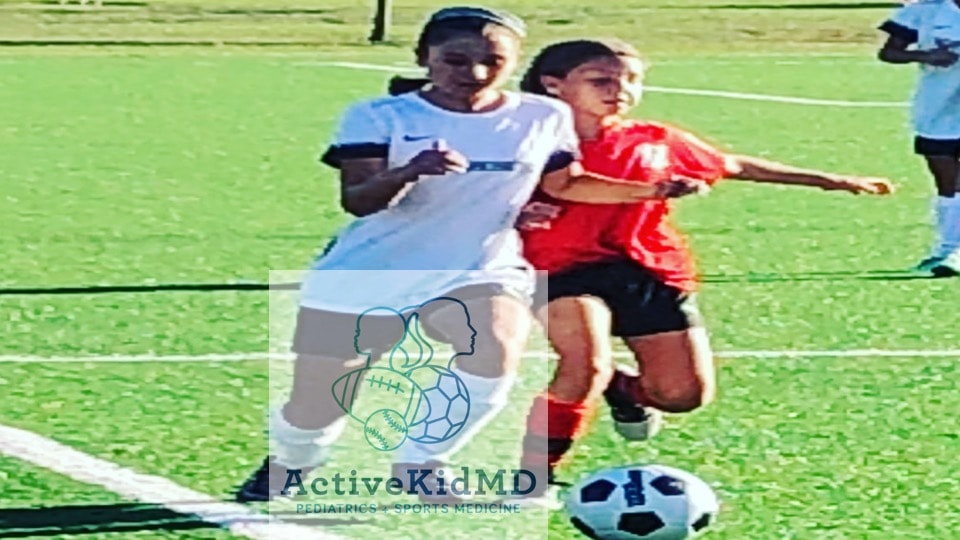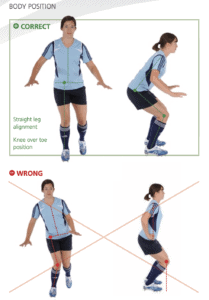Just put together an updated talk on ACL Injury in children where the news isn’t all good.
Yes, we’re pretty capable of getting kids back to sport (80% success rate).
However, we’re not very capable of preventing an all too common risk of early joint destruction or arthritis once an ACL injury occurs.
The only way to reduce months and years of worry and tears?
Take a few minutes to read on – just like it takes only a few minutes to help reduce ACL injuries.
Know an up-and-coming star young athlete?
Especially one who is female , in junior or senior high school, and plays sports (emphasis on plural) such as soccer, basketball, or lacrosse where cutting and turning are common?
(Related Topic: Young athletes who play multiple sports before high school have the best long-term athletic development and performance)
Certain you want to do all you can to provide for her future health and success while reducing the risk of major injury.
The ACL (Anterior Cruciate Ligament) is a major supporter of the knee that allows for jumping, turning and changing direction.
Tear your ACL, and you’ve got a major injury- which can create issues not just for weeks or months but potentially for many years.

ACL Injuries are happening too often, especially in young female athletes.
ACL Injury: By The Numbers
14-18 years of age: highest risk time for ACL Injuries
2-6 times higher: risk for girls versus boys in that 14-18 year old (high school) age range
6-9+ months: length of rehab after ACL Surgery (don’t believe the hype of only 6 months- research is finding longer rehab is better)
23%: risk of 2nd ACL Injury in athletes under 25 who return to sport (same or opposite knee)
50%: risk of early onset arthritis of the knee after ACL tears, as soon as 5 years from injury (READ AGAIN FOR EMPHASIS)
(Yes, that means that 19-24 year olds could be on the fast track to knee replacements)
So, if you happen to be a young female high school athlete playing a higher-risk sport, those last three sentences (and especially the last two) should really scare you.
So, if you happen to be a family member or coach of a young female high school athlete playing a higher-risk sport, those last three sentences (and especially the last two) should really scare you.
One more set of numbers:
10-15 minutes: length of a proper evidence-based ACL Injury Prevention Program
Yes- a mere 10-15 minute investment 3 times a week can help reduce a major injury, major rehab period and major risk of arthritis.
Oh, and there’s the added bonus of maybe making an athlete run and jump more efficiently.
Sound like a pretty good deal?
ACL Injury: Common Excuses for Not Doing Prevention Programs
Given the misery of ACL Injuries, you’d think prevention programs would be a pretty easy sell.
Have to admit that I far too often hear common explanations/excuses for not doing them.
Our team doesn’t have the time to do them
(they take 10-15 minutes)
With limited practice time, don’t want to take away from other important on-field drills or scrimmages
(they replace the usual 10-15 minute warm-up)
They’ll take a while to learn, and this part of the season is not the best to start something new
(seasons never seem to end, so why not start now)
We’re not sure what to do, and even if we need to do them in the first place
(read those ugly statistics again)
We’re already doing fitness training and conditioning- does this count?
(maybe, read below to find out if your program passes muster)
ACL Injury: What Can We Do for Prevention?
These are some key parts of an evidence-based ACL Injury Prevention Program:
- Incorporate strength, plyometrics and sports-specific agility training
- Straightforward to implement
- Little to no equipment
- Part of regular team training or physical education 2–3 times per week
- Coach and athlete education on cutting/landing techniques that avoid high-risk knee positions
What exactly are those high-risk knee positions that we are trying to avoid?
Here’s where pictures speak a thousand words….
The caving-in bending of the straight knee (called dynamic valgus on extended knee) puts abnormal stress on all knee structures and especially the ACL.
This dynamic valgus on extended knee often occurs with landing from a jump, cutting, or rapid change of direction.
(Related Topic: Soccer ACL Injuries: Two Common Movements Often Lead to Tears)
The goals of a prevention program- learn to land and turn softly with bent knees that don’t cave in.
ACL Injury: Bring on the Prevention Programs
After all that build-up, here are some well-studied evidence-based programs that are user-friendly and easier to include in training sessions.
FIFA 11+ Kids
For 7-13 year-olds and focuses on three key areas of injury prevention:
IMPROVING COORDINATION AND BALANCE
STRENGTHENING THE LEG AND CORE MUSCLES
OPTIMISING FALLING TECHNIQUES
FIFA 11+ Kids has shown an impressive injury reduction of about 50% as a warm-up.
Match injuries were reduced by 31%, training injuries by 40%, lower extremity injuries by 41%, overall non-contact injuries by 55% and severe injuries by 56%.
FIFA 11+
The “11+” was developed by an international group of experts for amateur players aged 14 or older.
It is a complete warm-up package and should replace the usual warm-up prior to training.
In a scientific study, it was shown that teams using the “11+” as a standard warm-up had a significant lower risk of injury than teams that warmed up as usual.
The “11+” has three parts with a total of 15 exercises, which should be performed in the specified sequence at the start of each training session.
- 1: running exercises at a slow speed combined with active stretching and controlled partner contacts
- 2: six sets of exercises focusing on core and leg strength, balance and plyometrics/ agility, each with three levels of increasing difficulty
- 3: running exercises at moderate / high speed combined with planting / cutting movements.
Santa Monica Sports Medicine Research Foundation
The PEP Program: Prevent Injury and Enhance Performance
The PEP Program is a soccer-oriented exercise program designed by doctors, physical therapists, and athletic trainers
It can be done on a field and requires no special equipment.
The program takes approximately 15 to 20 minutes to complete and should replace standard warm-up routine.
It should be done two or three times each week and there is a modified version for athletes under 12 years of age.
ACL Injury: The Final Words on Prevention
Don’t add to the sad statistics- add to the positive statistics of athletes working to prevent ACL Injuries.
Reduce the potential of spending months off the field, the constant worry of re-injury, and a real scary concern of early-onset knee arthritis.
Parents and coaches- add value to your team and club while protecting your greatest assets- young female athletes.
ActiveKidMD is your partner for health- contact us for more information on ACL Injury prevention or any other pediatric or sports medicine questions.






